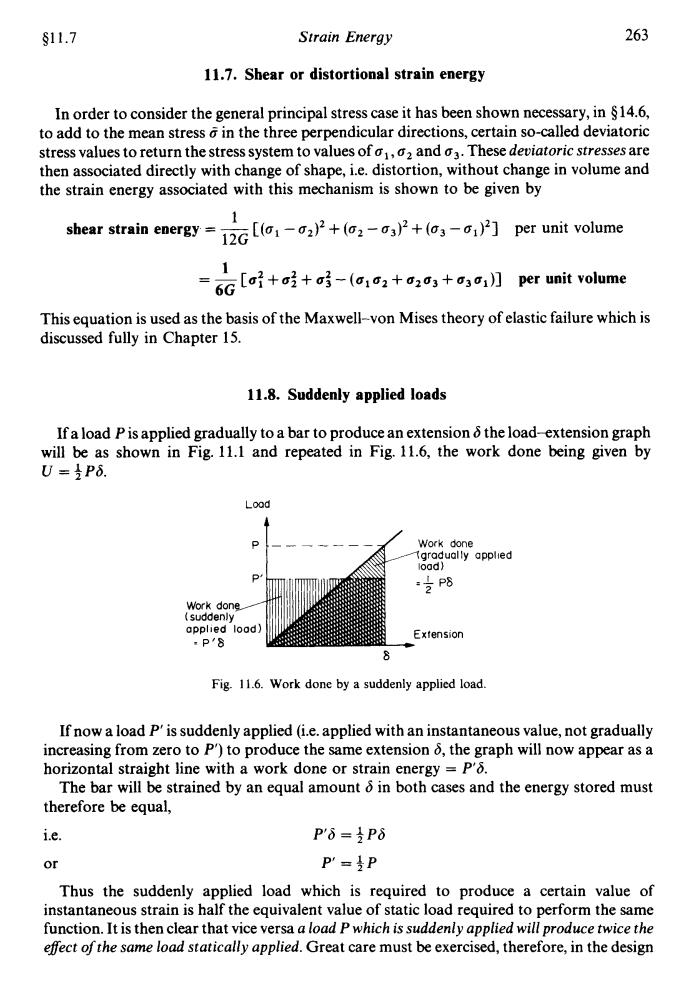正在加载图片...

S11.7 Strain Energy 263 11.7.Shear or distortional strain energy In order to consider the general principal stress case it has been shown necessary,in $14.6, to add to the mean stress in the three perpendicular directions,certain so-called deviatoric stress values to return the stress system to values of o,o2 and o3.These deviatoric stresses are then associated directly with change of shape,i.e.distortion,without change in volume and the strain energy associated with this mechanism is shown to be given by shear strain energy-2[(()]per unit volume 6G[oi+吃+of-(a12+a2o3+a3o,】per unit volume This equation is used as the basis of the Maxwell-von Mises theory of elastic failure which is discussed fully in Chapter 15. 11.8.Suddenly applied loads If a load Pis applied gradually to a bar to produce an extension the load-extension graph will be as shown in Fig.11.1 and repeated in Fig.11.6,the work done being given by U=P6. Lood Work done gradually applied load) .P8 Work done suddenly applied load) Extension P‘8 Fig.11.6.Work done by a suddenly applied load. If now a load P'is suddenly applied(i.e.applied with an instantaneous value,not gradually increasing from zero to P')to produce the same extension o,the graph will now appear as a horizontal straight line with a work done or strain energy =P'8. The bar will be strained by an equal amount o in both cases and the energy stored must therefore be equal, i.e. P'δ=支P8 or P=P Thus the suddenly applied load which is required to produce a certain value of instantaneous strain is half the equivalent value of static load required to perform the same function.It is then clear that vice versa a load P which is suddenly applied will produce twice the effect of the same load statically applied.Great care must be exercised,therefore,in the design$11.7 Strain Energy 263 11.7. Shear or distortional strain energy In order to consider the general principal stress case it has been shown necessary, in 5 14.6, to add to the mean stress 5 in the three perpendicular directions, certain so-called deviatoric stress values to return the stress system to values of al, a’ and a3. These deuiatoric stresses are then associated directly with change of shape, i.e. distortion, without change in volume and the strain energy associated with this mechanism is shown to be given by 1 12G 1 6G shear strain energy = __ [(a, - a’)’ + (a2 - a3)’ + (a3 - ol)’] = - [u: + u: + t~: - (al u2 + u2 uj + uj ul )] per unit volume This equation is used as the basis of the Maxwell-von Mises theory of elastic failure which is discussed fully in Chapter 15. per unit volume 11.8. Suddenly applied loads If a load Pis applied gradually to a bar to produce an extension 6 the load-extension graph will be as shown in Fig. 11.1 and repeated in Fig. 11.6, the work done being given by u = iP6. Fig. 11.6. Work done by a suddenly applied load. If now a load P’ is suddenly applied (i.e. applied with an instantaneous value, not gradually increasing from zero to P’) to produce the same extension 6, the graph will now appear as a horizontal straight line with a work done or strain energy = P‘6. The bar will be strained by an equal amount 6 in both cases and the energy stored must therefore be equal, i.e. P’6 = 3P6 or p’ = &p Thus the suddenly applied load which is required to produce a certain value of instantaneous strain is half the equivalent value of static load required to perform the same function. It is then clear that vice versa a load P which is suddenly applied will produce twice the effect of the same load statically applied. Great care must be exercised, therefore, in the design